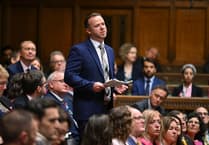The fertility rate fell in Cornwall and the Isles of Scilly last year, new figures show.
Similarly, the rate for England and Wales fell to a historical low for the third year in a row.
Earlier this year, Education Secretary Bridget Phillipson called for Britons to have more children sooner, warning of the "worrying repercussions" of declining fertility rates.
New figures from the Office for National Statistics show the total fertility rate in Cornwall and the Isles of Scilly stood at 1.31 children per woman in 2024.
It was down from 1.4 the previous year.
The total fertility rate is defined as the average number of live children women would expect to have across their childbearing life.
Separate ONS statistics from earlier this year show 4,082 live births were recorded in Cornwall and the Isles of Scilly in 2024 – a 6% fall from 4,346 the previous year.
Across England and Wales, the total fertility rate stood at 1.41 last year – down from 1.42 in 2023.
It means the rate fell for the third year in a row to reach a new record low, and it is the lowest figure since comparable data began in 1938, according to the ONS.
This is despite the number of births increasing slightly last year, from 591,072 in 2023 to 594,677 in 2024.
But the size of the overall population rose which meant fertility rates across the two nations fell overall.
The figures also reveal regional disparities in the rate and its evolution.
As most regions saw a drop in their total fertility rate last year, London and the West Midlands region recorded an increase from 2023.
At a local authority level, Luton in Bedfordshire had the highest total fertility rate in 2024 (two children per woman), followed by Barking and Dagenham in London (1.99) and Slough in Berkshire (1.96).
Meanwhile, the City of London had the lowest rate (0.32), followed by Cambridge (0.95) and Brighton and Hove in East Sussex (0.97).
Greg Ceely, ONS head of population health monitoring, said: "Fertility rates in England and Wales have been in overall decline since 2010.
"The total number of births increased last year, for the first time since 2021, but this was offset by population growth.
"As a result, fertility rates fell overall, and are now at the lowest rates on record."
Education Secretary Bridget Phillipson called for Britons to have more children sooner, warning of the "worrying repercussions" of declining fertility rates.
She told The Daily Telegraph in June: "A generation of young people have been thinking twice about starting a family, worried not only about rising mortgage and rent repayments, wary not only of the price of fuel and food but also put off by a childcare system simultaneously lacking in places and ruinously expensive."
The figures also show the standardised mean age of mothers in England and Wales was 31 years last year, while for fathers it was 33.9.
It means both standardised mean ages increased by 0.1 years from 2023.




